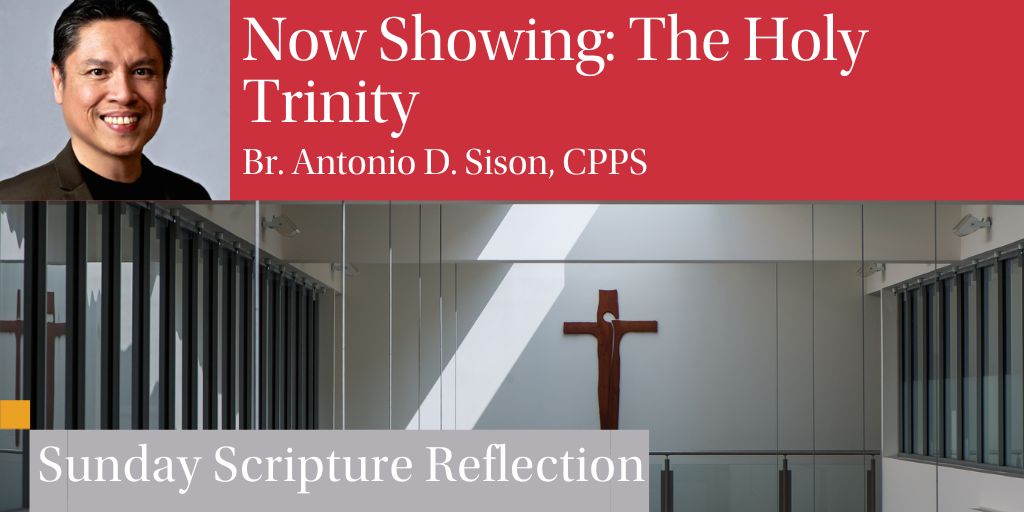
From the 1912 film From the Manger to the Cross, to an anticipated Mel Gibson sequel titled The Passion of the Christ: Resurrection, the “Jesus-Film” genre is well established in the cinematic universe. Jesus, after all, was a historical figure whose birth, ministry, death, and resurrected presence, found narrative expression in four gospels; there is some concrete source material from which to base artistic representations of him.
Not so with the Holy Trinity. While, as our Trinity Sunday gospel reading from Matthew attests, the New Testament configures salvation and mission in a definitive Trinitarian pattern—God redeems through Christ in the power of the Holy Spirit—it offers neither concrete descriptions, nor doctrinal explications, of the divine tripersonal relations and how this is brought to bear contextually in faith life. The creedal statements and theological reflections that subsequently developed over time are complex, speculative, and necessarily paradoxical.
The Holy Trinity, ineffable and divinely mysterious, obviously does not make for an ideal subject for a movie screenplay! Thus, one would be hard pressed to find films with explicit Trinitarian thematic references, let alone literal “Trinity-Films.” Among the visual arts, it is painting that allows for a better understanding of the Trinity by offering one-dimensional, symbolic imagery that opens a window for the viewer’s engagement and interpretation. An example of this is Andrei Rublev’s renowned 5th century Orthodox icon The Trinity (also known as The Hospitality of Abraham), which, in its allusive approach to divine mystery, has invited a rich diversity of thought and reflection.
To my knowledge, there is one fairly recent Hollywood film that ventures to present a literalist cinematic portrait of God the Trinity. Based on the bestselling Christian novel of the same title, The Shack (2017) grapples with difficult theological themes such as evil, suffering, trauma, and eternal life. The lead character, transitioning to the afterlife, unknowingly enters a liminal space where he encounters the Holy Trinity personified in three characters: Papa-Elousia, a motherly African American woman (God the Father); Sarayu, a graceful Asian woman (Holy Spirit); and an amiable Middle Eastern young man who straightforwardly goes by “Jesus.”
It is refreshing to see two of the persons of the Trinity represented as feminine figures. The character of Papa-Elousia, who retains the fatherly appellation “Papa,” brings to mind a similar gender inclusive naming expressed by the late Pope John Paul I in a 1978 Angelus. Amid the raging war in the Middle East, JPI appeals to the divine love of a Father-Mother in his contextually urgent heartcry: “He has always his eyes open on us even when it seems dark. He is our father; even more, God is our mother (emphasis mine).” As an imaginative take on the Holy Spirit who is not conventionally associated with a human-personal analogue, Sarayu—from the Sanskrit term meaning “the wind,” which is a scriptural allusion to God as ruach—is depicted as a wisdom figure, not unlike the personification of God as “Sophia” in the biblical Wisdom tradition. Meaningfully, the third person as “Spirit-Sophia” is creatively and eloquently proposed by Elizabeth Johnson in her now classic work She Who Is: The Mystery of God in Feminist Theological Discourse (1992). The one character in the film who seamlessly fits into the popular theological imagination is Jesus; charismatic and thoroughly relatable, he is “Jesus as a friend,” a reassuring bearded guy who might even look the part.
To be sure, The Shack deserves credit for audaciously taking on the task of representing the Holy Trinity, accessibly and interculturally, on the silver screen. That said, it tips the scales too much on the side of “tritheism,” that is, the over-statement of the distinction between the three persons at the expense of the “tri-unity” of the one divine substance. It is apparent that the the divine persons in the film possess three separate consciousness and wills. In The God of Jesus Christ (1991), Cardinal Walter Kasper emphasizes the importance of a dynamic, mutual, being-in-another—theologically referred to as perichoresis—in understanding the divine tripersonal relations where, paradoxically, “The three persons are (in the language of Christology) ‘without confusion and without separation.’”
Realistically, the more relevant cinematic approach is a non-literalist reflection on the saving Trinity in the profound experience of communion in Church life, no matter how humanly imperfect—in the sacraments, in radical hospitality, in forgiveness and reconciliation, in care for the earth, in an option for the poor. For this, cinematic parables such as the enduring “religious” favorite Babette’s Feast (the first film ever to be cited in a Papal encyclical–Amoris Laetitia), and the true-to-life African narrative The Queen of Katwe (2016), lend themselves to a deeper, more contextual reflection of “God for us,” the Holy Trinity at the heart of our story.
Beyond my theological quibbles, it’s notable that The Shack, as well as the two other films mentioned, turn the prism to reveal the “divine feminine” in the Trinity. In doing so, they expand our theological imagination so that we can more deeply reflect on God as a plenitude of self-giving love, an inclusive love that transcends the one-sided gendered imagery we have long been attached to. Then, with Professor Emerita Sr. Sandra Schneiders, we can conclude, “God is not two men and a bird.”
Antonio D. Sison, CPPS
Vatican Council II Chair, Professor of Systematic Theology and Culture
